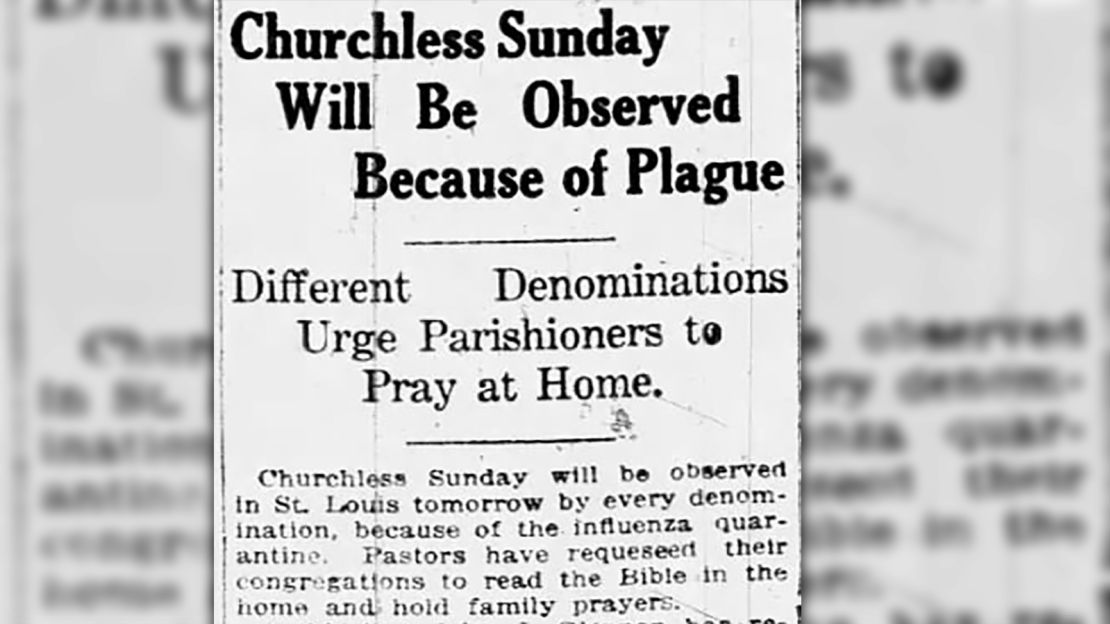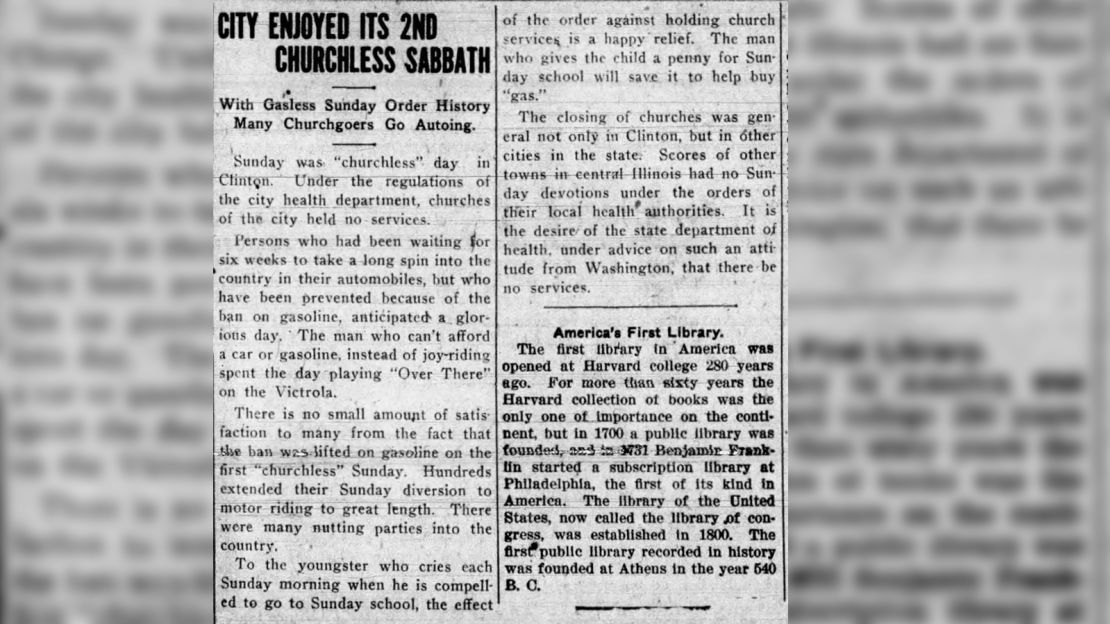To gather or not to gather has been the question at the forefront of the minds of today’s religious leaders and their church members.
During the 1918 influenza pandemic that ultimately killed 50 million to 100 million people, different answers to that same question resulted in either collective well-being or widespread, devastating loss.

The US Supreme Courtrecently decided 5-4 to grant religious organizations in New York state relief from restrictions on the number of people attending religious services. In light of this development, looking back a century can offer guidance for religious institutions deciding to stay shuttered or reopen.
Self-inflicted decimation
In 1918, many churches around the world closed their doors to save lives. Without financial support, some churches eventually closed permanently, while others survived with dropped-off donations and serving as hospitals instead of sanctuaries. For some families, the home became the altar.
Those who refused to adapt to the pandemic reaped the consequences.

In Zamora, Spain, “mass gatherings were positively encouraged — and at 3 per cent, or more than twice the national average, Zamora had the highest death rate of any city in Spain,” wrote science journalist Laura Spinney in her book “Pale Rider: The Spanish Flu of 1918 and How It Changed the World.”
In September, a local bishop rebelled against health authorities by ordering evening prayers for nine days “in honour of St. Rocco, the patron saint of plague and pestilence, because the evil that had befallen Zamoranos was ‘due to our sins and ingratitude, for which the avenging arm of eternal justice has been brought down upon us,’ ” Spinney wrote.
On the first day, “he dispensed Holy Communion to a large crowd at the Church of San Esteban. At another church, the congregation was asked to adore relics of St. Rocco, which meant lining up to kiss them,” she wrote.
“Organised religion shaped the pandemic much more obviously then than now, and it was more likely to take precedence over public health,” Spinney told CNN via email. “In the pages of Zamora’s newspapers … a notice announcing an upcoming mass at one of the city’s churches was printed next to a warning to avoid crowds. Nobody seemed to notice the incompatibility of the two.”
A month later, Spinney notes in her book, the bishop wrote that science had proven itself ineffective and that people were beginning to “turn their eyes instead toward heaven.” People continued to attend gatherings in packed cathedrals and streets. When health officials tried to prohibit gatherings, the bishop accused them of interfering in church affairs.

By mid-November, Zamora had seen more illness and death than any other Spanish city. Although priests and parishioners lost their lives, Spinney wrote, the bishop praised those who had placated, in his words, “God’s legitimate anger” by attending services. The bishop’s followers didn’t hold him accountable but rather revered him, and he was awarded for his efforts and remained bishop for nearly a decade longer.
Across the globe, villagers dwelling on the Seward Peninsula of Alaska were also experiencing the tail end of their pandemic nightmare around the end of November.
On the last Saturday of the month, two visitors from Nome, Alaska, attended a standing-room-only service in the small local chapel. The Nome visitors relayed that many people back home were sick, but no one was seriously alarmed, wrote Gina Kolata, a science and medicine reporter for The New York Times, in her book “Flu: The Story of the Great Influenza Pandemic of 1918 and the Search for the Virus That Caused It.”
Two days after the service of singing, prayer and feasting, villagers became sick with the flu. Of the 80 local Eskimo villagers, 72 died and their bodies were left frozen in igloos. In one igloo, dogs had scavenged corpses.
“Another igloo looked at first like the site of utter devastation,” Kolata wrote. “And as rescuers peeked inside, they saw only a pile of corpses. Then, suddenly, three terrified children appeared from under deerskins and started shrieking. They had survived somehow on oatmeal, surrounded by the bodies of their family.”
By the end of the three-week outbreak, the village housed only five adults and 46 orphaned children. According to Kolata’s book, Clara Fosso, a missionary’s wife who didn’t get sick, wrote a regretful letter to the Eskimos years later:
“There was a spiritual revival among the Eskimos at the Mission on the last Sunday in November 1918, before the influenza disaster fell upon us. The whole settlement of Eskimos had crowded into the new school room for worship. We felt the spirit of the Lord among us, as the communicants stood at the altar and later met in prayer; many confessed to their faith. We were deeply moved. This was the last time we were gathered together.
“By the following Sunday most members had gone to a more beautiful service with their Savior. You, who are the sons and daughters of these children of God, may remember that many of them died testifying to their Lord and singing the hymn that we had shared on that last Sunday, ‘I Can Hear My Savior Calling.’”
Why some think services are worth the risk
What people generally receive when attending religious services is a sense of comfort, spiritual community and grounding, said Dr. Christina Puchalski, the founder and director of the George Washington Institute for Spirituality & Health in Washington, DC. “People have that sense of connection and belonging, and then in a transcendent sense, maybe the experience of God, however people understand that. Rituals can be very healing and faith, for many people, is their source of hope. … That is what sustains them.”
During the pandemic, the rug has been pulled out from underneath believers and there are few places where they — and really, anyone — can feel hope, Puchalski said.
“When it comes to religious services, it’s more than going out to a restaurant,” she said. “When you think historically, in countries where people were persecuted for their faith, people went to church or mosque or temple anyway, in spite of the possibility that they would be killed. Because that is so important to them. That is who they are at a very profound level.”
“It is true that for a number of different religions, the creation of communities for rituals is incredibly important,” said Stephen Covell, the chair of the department of comparative religion at Western Michigan University. “And if you can’t come together to celebrate or worship or conduct whatever the ritual is, then it means you’re unable to fulfill the teachings of that religion or … the duties and responsibilities you have.”
On the other hand, some churchgoers may have different beliefs about the severity of the pandemic and how to handle it, Puchalski said. And some vary in how they assess risk. Others might be fed up with isolation burnout, deciding that attending church is worth the risk and that if they catch coronavirus, maybe their sickness would be mild.
Denial is one coping mechanism that could give people subconscious permission to live life as normal. Any of those schools of thought could lead someone “to make decisions accordingly,” Puchalski said.
Indiana: Where opportunity was found amid crisis
The innovative spirit for reimagining religious services during pandemics didn’t start in 2020.
Although much less technologically savvy, religious leaders and parishioners living during the 1918 pandemic devised ways to maintain both individual faith and community spirituality.
When influenza struck in Indiana in the fall of 1918, the second and worst wave of the 1918 flu, health officials imposed a statewide quarantine beginning October 6 of that year. Nevertheless, religious leaders took advantage of the opportunity to ingeniously unite and console their parishioners, wrote Casey Pfeiffer, a historian with the Indiana Historical Bureau, a division of the Indiana State Library.
The press, for one, acted as a sort of liaison between leaders and members: Through local papers, leaders stayed connected with members by providing hope and ways to practice their religion. Readers were encouraged to study scripture readings or Sunday school lessons, or worship alone or with family.
In a published statement, a reverend suggested that families pray at the same time that services were usually held. And once the quarantine was extended to the end of October, First Presbyterian Church in Rushville, Indiana, urged families to make Sunday “a day of prayer and meditation in their homes.”
As the pandemic droned on, some newspapers shifted to having larger sections designated for guides to at-home Sunday services. In “Worship with the Star,” a series by the Indianapolis Star newspaper, there was a full page that featured opening and adjourning hymns, scripture lessons and sermons.
One reverend worked with a telephone company to facilitate dial-in services. “There was that sense of responsibility and wanting to really make sure that religion remained a focus in people’s lives,” Pfeiffer said. “The past really informs us about the present and then, if we can, hopefully it inspires us to work toward a better future.”
Though members and religious leaders figured out how to cope, not everyone was satisfied with the adjustments. “As we see today,” Pfeiffer said, “there was some pushback against that, people who wanted to be in person.”
Some church leaders hosted open air services, as they thought short meetings in sufficiently ventilated churches wouldn’t seriously harm communities. Recognizing the danger, health authorities and law enforcement intervened in some places, either by discouraging the services, denying permission to have them or dispatching officers to meetings. At the height of the fall wave, some pastors and rabbis used their buildings as makeshift hospitals.
In late November 1918, some religious institutions slowly reopened while imagining the future of church — which included, for example, curtailing the length or number of services, mandating mask wearing and instructing preachers to dedicate a portion of their messages to guidance for proper ventilation in members’ homes and workplaces.
“It was challenging then; it’s challenging now,” Pfeiffer said. “Religious leaders, both then and now, are trying to do the best that they can to meet their parishioners’ needs, while keeping their safety and health at the (forefront) as well. There are definitely parallels to draw from and hope to be had.”
Staying spiritually connected individually and together
Although we’ve had the carpet pulled out from underneath our feet, “there are many things that provide that sense of being grounded, sort of a replacement for that carpet,” Puchalski said. There are “so many creative ways that I’m participating myself. I could go to Mass all over the world, because of YouTube. It’s so neat to hear homilies from different places.”
Today’s believers have stayed connected via virtual Bible or prayer meetings, service livestreams, drive-in services and more. “Covid is still here, there’s no really effective treatment, and there’s no vaccine yet that’s available,” Puchalski said. “As long as that’s the case, I would continue to follow the CDC (guidelines).”
Get CNN Health's weekly newsletter
Sign up here to get The Results Are In with Dr. Sanjay Gupta every Tuesday from the CNN Health team.
The crux of the situation “ultimately boils down to a relationship with God,” Puchalski said. “Yes, for many people, their faith is practiced in community, no question — a huge loss for many people who, for them, that is important.
“We get so caught up with that that maybe we forget another way that we can honor that belief within us that just might be safer. And that the bigger picture is the relationship with, again, God, divine or sacred, however you understand it.”









